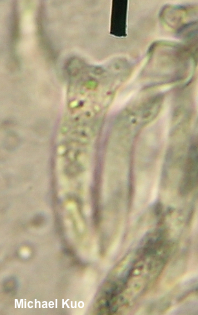| Major Groups > Jelly Fungi > Dacrymyces stillatus |

|
Dacrymyces stillatus [ Basidiomycota > Dacrymycetales > Dacrymycetaceae > Dacrymyces ... ] by Michael Kuo A small, yellowish orange, gelatinous blob. There's not much to Dacrymyces stillatus. It is usually under a centimeter across. Although it is usually blob-shaped, it sometimes appears like a little disc—and occasionally it develops "cerebriform" (brainlike) wrinkles. Sometimes it seems to have a vaguely defined pseudostem, but other times it does not. It grows from conifer wood and the wood of hardwoods, on decorticated, bark-less sticks, or "erumpent" through still-attached bark. In other words, as the species is currently defined, it's pretty variable, and might be better thought of as a species complex in need of critical study. Microscopic features for Dacrymyces stillatus include Y-shaped basidia, sausage-shaped spores that develop 3 septa at maturity, and the absence of clamp connections. Additionally, asexual "arthrospores" formed by the disintegration of chain-like cells are often present. Similar species include Dacrymyces capitatus, which often forms more of a stem-like base, never develops arthrospores, and features spores with thin (rather than thick) septa—and Dacrymyces minor, with smaller fruiting bodies measuring 1–3 mm across at maturity. Femsjonia peziziformis looks similar on casual inspection, but under scrutiny is revealed as not only a little larger, but also broadly ob-conic, with a flattened top and sloping sides that are finely hairy. Synonyms include Dacrymyces deliquescens and Dacrymyces abietinus. Description: Ecology: Saprobic; growing gregariously on the wood of hardwoods (especially oaks) or conifers; spring through fall, or over winter in warm climates; originally described from Europe; widely distributed throughout Europe, Asia, and Oceania; in North America widely distributed from Alaska to Mexico, Florida, and the Maritime Provinces. The illustrated and described collections are from Illinois. Fruiting Body: 2–8 mm across; usually blob-like or cushion shaped, but occasionally with brain-like wrinkles; surface bald and shiny, moist or sticky when fresh; sometimes with a vaguely stem-like basal portion; yellow to orange-yellow or yellow-orange; flesh gelatinous. Odor: Not distinctive. Microscopic Features: Spores 12–15 x 6–8 µm; allantoid or elongated-ellipsoid; thick-walled; apiculate; smooth; hyaline in KOH, with many oil droplets; tardily becoming septate with 1–3 thick septa; developing knoblike projections with germination. Probasidia 45 x 4–5 µm; subclavate to clavate; developing 2 short, stubby apical protrusions that eventually extend to become sterigmata on mature basidia. Basidia Y-shaped; to 60 x 5 µm, with sterigmata 12–20 µm long. Contextual hyphae 1.5–3 µm wide; smooth or a little roughened; hyaline in KOH; clamp connections not found. Arthrospores often present, disarticulating from chained structures; 3–5 x 2–3.5 µm; subglobose to broadly ellipsoid; smooth; thick-walled; hyaline in KOH. REFERENCES: Nees, 1817. (Coker, 1920; Brasfield, 1938; Olive, 1947; Martin, 1952; Kennedy, 1958; Lowy, 1971; McNabb, 1973; Reid, 1974; Phillips, 1981; Breitenbach & Kränzlin, 1986; Pérez-Silva & Valle, 1992; Gilbertson & Adaskaveg, 1993; Volk et al., 1994; Gilbertson et al., 2002; Shirouzu et al., 2009; Trudell & Ammirati, 2009; Buczacki et al., 2012; Shirouzu et al., 2013; Desjardin, Wood & Stevens, 2015; Castro-Santiuste et al., 2017; Gminder & Böhning, 2017; Shirouzu et al., 2017; Læssøe & Petersen, 2019; Zamora & Ekman, 2020.) Herb. Kuo 04100902, 04190902, 04171301, 05101301, 04291703. This site contains no information about the edibility or toxicity of mushrooms. |
© MushroomExpert.Com |
|
Cite this page as: Kuo, M. (2021, April). Dacrymyces stillatus. Retrieved from the MushroomExpert.Com Web site: http://www.mushroomexpert.com/dacrymyces_stillatus.html |







